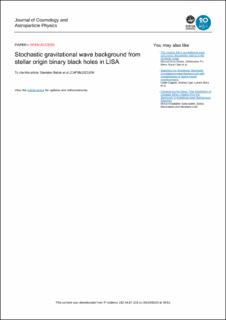| dc.contributor.author | Babak, Stanislav | |
| dc.contributor.author | Caprini, Chiara | |
| dc.contributor.author | Figueroa, Daniel G. | |
| dc.contributor.author | Karnesis, Nikolaos | |
| dc.contributor.author | Marcoccia, Paolo | |
| dc.contributor.author | Nardini, Germano | |
| dc.contributor.author | Pieroni, Mauro | |
| dc.contributor.author | Ricciardone, Angelo | |
| dc.contributor.author | Sesana, Alberto | |
| dc.contributor.author | Torrado, Jesús | |
| dc.date.accessioned | 2024-02-21T09:06:53Z | |
| dc.date.available | 2024-02-21T09:06:53Z | |
| dc.date.created | 2023-09-27T11:00:55Z | |
| dc.date.issued | 2023 | |
| dc.identifier.citation | Babak, S., Caprini, C., Figueroa, D. G., Karnesis, N., Marcoccia, P., Nardini, G., Pieroni, M., Ricciardone, A., Sesana, A., & Torrado, J. (2023). Stochastic gravitational wave background from stellar origin binary black holes in LISA. Journal of Cosmology and Astroparticle Physics, 2023(08), 034. | en_US |
| dc.identifier.issn | 1475-7516 | |
| dc.identifier.uri | https://hdl.handle.net/11250/3118894 | |
| dc.description.abstract | We use the latest constraints on the population of stellar origin binary black holes (SOBBH) from LIGO/Virgo/KAGRA (LVK) observations, to estimate the stochastic gravitational wave background (SGWB) they generate in the frequency band of LISA. In order to account for the faint and distant binaries, which contribute the most to the SGWB, we extend the merger rate at high redshift assuming that it tracks the star formation rate. We adopt different methods to compute the SGWB signal: we perform an analytical evaluation, we use Monte Carlo sums over the SOBBH population realisations, and we account for the role of the detector by simulating LISA data and iteratively removing the resolvable signals until only the confusion noise is left. The last method allows the extraction of both the expected SGWB and the number of resolvable SOBBHs. Since the latter are few for signal-to-noise ratio thresholds larger than five, we confirm that the spectral shape of the SGWB in the LISA band agrees with the analytical prediction of a single power law. We infer the probability distribution of the SGWB amplitude from the LVK GWTC-3 posterior of the binary population model: at the reference frequency of 0.003 Hz it has an interquartile range of h2ΩGW(f = 3 × 10-3 Hz) ∈ [5.65, 11.5] × 10-13, in agreement with most previous estimates. We then perform a MC analysis to assess LISA's capability to detect and characterise this signal. Accounting for both the instrumental noise and the galactic binaries foreground, with four years of data, LISA will be able to detect the SOBBH SGWB with percent accuracy, narrowing down the uncertainty on the amplitude by one order of magnitude with respect to the range of possible amplitudes inferred from the population model. A measurement of this signal by LISA will help to break the degeneracy among some of the population parameters, and provide interesting constraints, in particular on the redshift evolution of the SOBBH merger rate. | en_US |
| dc.language.iso | eng | en_US |
| dc.publisher | IOP Publishing | en_US |
| dc.rights | Navngivelse 4.0 Internasjonal | * |
| dc.rights.uri | http://creativecommons.org/licenses/by/4.0/deed.no | * |
| dc.title | Stochastic gravitational wave background from stellar origin binary black holes in LISA | en_US |
| dc.type | Peer reviewed | en_US |
| dc.type | Journal article | en_US |
| dc.description.version | publishedVersion | en_US |
| dc.rights.holder | The authors | en_US |
| dc.subject.nsi | VDP::Matematikk og Naturvitenskap: 400::Fysikk: 430 | en_US |
| dc.source.volume | 2023 | en_US |
| dc.source.journal | Journal of Cosmology and Astroparticle Physics (JCAP) | en_US |
| dc.source.issue | 8 | en_US |
| dc.identifier.doi | 10.1088/1475-7516/2023/08/034 | |
| dc.identifier.cristin | 2179311 | |
| cristin.ispublished | true | |
| cristin.fulltext | original | |
| cristin.qualitycode | 1 | |

